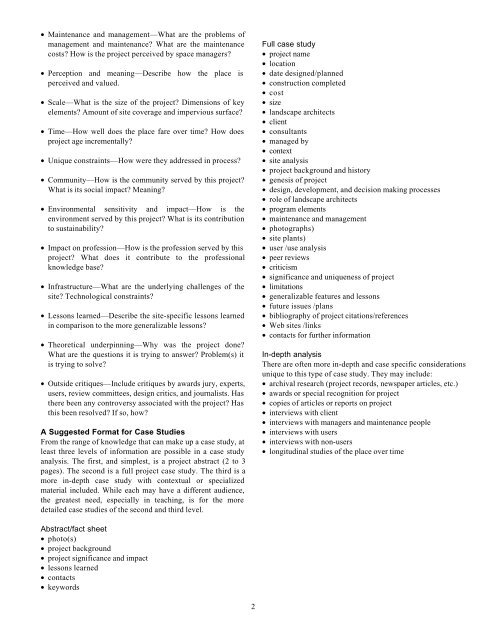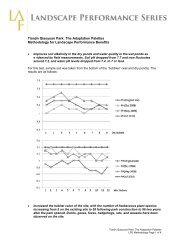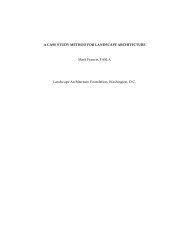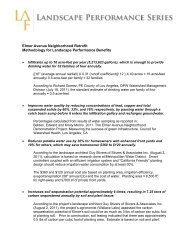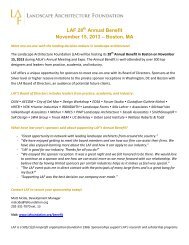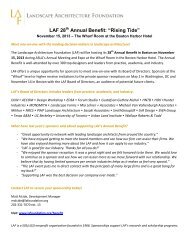A Case Study Method Abstract - Landscape Architecture Foundation
A Case Study Method Abstract - Landscape Architecture Foundation
A Case Study Method Abstract - Landscape Architecture Foundation
Create successful ePaper yourself
Turn your PDF publications into a flip-book with our unique Google optimized e-Paper software.
• Maintenance and management—What are the problems of<br />
management and maintenance? What are the maintenance<br />
costs? How is the project perceived by space managers?<br />
• Perception and meaning—Describe how the place is<br />
perceived and valued.<br />
• Scale—What is the size of the project? Dimensions of key<br />
elements? Amount of site coverage and impervious surface?<br />
• Time—How well does the place fare over time? How does<br />
project age incrementally?<br />
• Unique constraints—How were they addressed in process?<br />
• Community—How is the community served by this project?<br />
What is its social impact? Meaning?<br />
• Environmental sensitivity and impact—How is the<br />
environment served by this project? What is its contribution<br />
to sustainability?<br />
• Impact on profession—How is the profession served by this<br />
project? What does it contribute to the professional<br />
knowledge base?<br />
• Infrastructure—What are the underlying challenges of the<br />
site? Technological constraints?<br />
• Lessons learned—Describe the site-specific lessons learned<br />
in comparison to the more generalizable lessons?<br />
• Theoretical underpinning—Why was the project done?<br />
What are the questions it is trying to answer? Problem(s) it<br />
is trying to solve?<br />
• Outside critiques—Include critiques by awards jury, experts,<br />
users, review committees, design critics, and journalists. Has<br />
there been any controversy associated with the project? Has<br />
this been resolved? If so, how?<br />
A Suggested Format for <strong>Case</strong> Studies<br />
From the range of knowledge that can make up a case study, at<br />
least three levels of information are possible in a case study<br />
analysis. The first, and simplest, is a project abstract (2 to 3<br />
pages). The second is a full project case study. The third is a<br />
more in-depth case study with contextual or specialized<br />
material included. While each may have a different audience,<br />
the greatest need, especially in teaching, is for the more<br />
detailed case studies of the second and third level.<br />
Full case study<br />
• project name<br />
• location<br />
• date designed/planned<br />
• construction completed<br />
• cost<br />
• size<br />
• landscape architects<br />
• client<br />
• consultants<br />
• managed by<br />
• context<br />
• site analysis<br />
• project background and history<br />
• genesis of project<br />
• design, development, and decision making processes<br />
• role of landscape architects<br />
• program elements<br />
• maintenance and management<br />
• photographs)<br />
• site plants)<br />
• user /use analysis<br />
• peer reviews<br />
• criticism<br />
• significance and uniqueness of project<br />
• limitations<br />
• generalizable features and lessons<br />
• future issues /plans<br />
• bibliography of project citations/references<br />
• Web sites /links<br />
• contacts for further information<br />
In-depth analysis<br />
There are often more in-depth and case specific considerations<br />
unique to this type of case study. They may include:<br />
• archival research (project records, newspaper articles, etc.)<br />
• awards or special recognition for project<br />
• copies of articles or reports on project<br />
• interviews with client<br />
• interviews with managers and maintenance people<br />
• interviews with users<br />
• interviews with non-users<br />
• longitudinal studies of the place over time<br />
<strong>Abstract</strong>/fact sheet<br />
• photo(s)<br />
• project background<br />
• project significance and impact<br />
• lessons learned<br />
• contacts<br />
• keywords<br />
2


